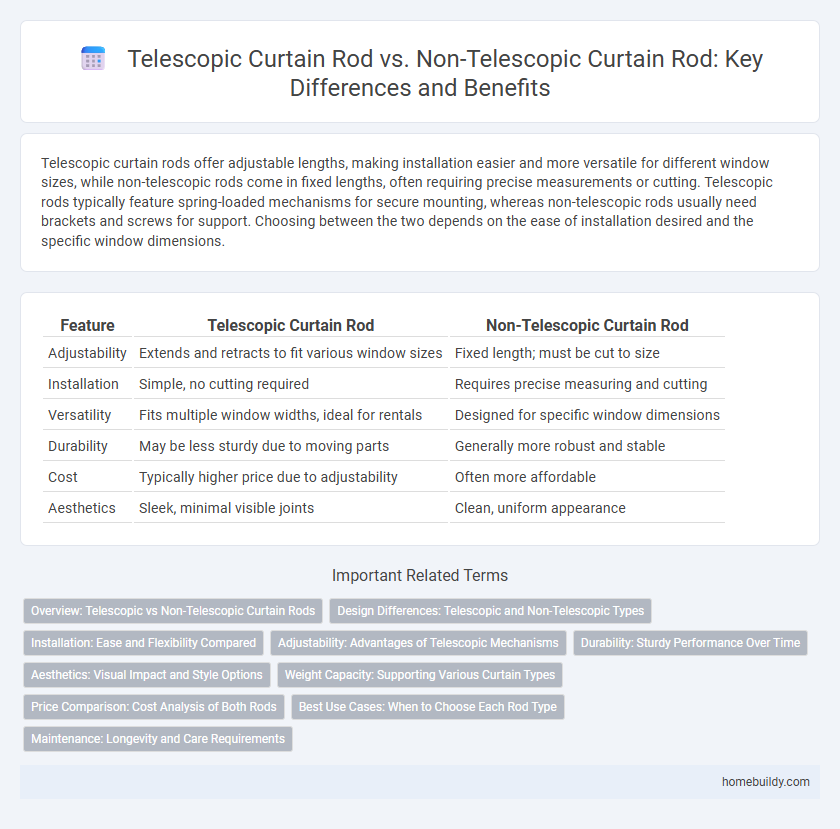Telescopic curtain rods offer adjustable lengths, making installation easier and more versatile for different window sizes, while non-telescopic rods come in fixed lengths, often requiring precise measurements or cutting. Telescopic rods typically feature spring-loaded mechanisms for secure mounting, whereas non-telescopic rods usually need brackets and screws for support. Choosing between the two depends on the ease of installation desired and the specific window dimensions.
Table of Comparison
| Feature | Telescopic Curtain Rod | Non-Telescopic Curtain Rod |
|---|---|---|
| Adjustability | Extends and retracts to fit various window sizes | Fixed length; must be cut to size |
| Installation | Simple, no cutting required | Requires precise measuring and cutting |
| Versatility | Fits multiple window widths, ideal for rentals | Designed for specific window dimensions |
| Durability | May be less sturdy due to moving parts | Generally more robust and stable |
| Cost | Typically higher price due to adjustability | Often more affordable |
| Aesthetics | Sleek, minimal visible joints | Clean, uniform appearance |
Overview: Telescopic vs Non-Telescopic Curtain Rods
Telescopic curtain rods feature adjustable lengths with overlapping sections, allowing versatile fit for various window sizes without the need for cutting or additional hardware. Non-telescopic curtain rods come in fixed lengths, often requiring custom sizing or bracket adjustments to fit specific window dimensions. Choosing between them depends on installation flexibility, window size variation, and aesthetic preference.
Design Differences: Telescopic and Non-Telescopic Types
Telescopic curtain rods feature adjustable lengths enabled by nested tubing, allowing seamless fit across various window sizes without the need for cutting, whereas non-telescopic rods come in fixed lengths requiring precise measurement and potential trimming. The design of telescopic rods prioritizes versatility and ease of installation with extendable sections locked by internal mechanisms, contrasting with the solid, single-piece construction of non-telescopic rods that offers greater stability and weight support. Material options and aesthetic finishes are similar, but telescopic models often include additional components for adjustment, slightly influencing their overall appearance compared to the streamlined design of non-telescopic rods.
Installation: Ease and Flexibility Compared
Telescopic curtain rods offer superior installation ease and flexibility due to their adjustable length, eliminating the need for precise measurements and additional hardware. Non-telescopic curtain rods require exact sizing beforehand, often demanding custom cutting or multiple rod sizes, which complicates installation. Adjustable design of telescopic rods allows quick modifications to fit varying window widths, enhancing versatility in mounting options.
Adjustability: Advantages of Telescopic Mechanisms
Telescopic curtain rods offer significant adjustability by extending and retracting to fit various window sizes without the need for precise measurements or multiple rod purchases. Their adjustable length mechanism provides flexibility in installation, making them ideal for irregular or changing window dimensions. In contrast, non-telescopic curtain rods come in fixed lengths, limiting versatility and often requiring custom cutting or multiple rods for different window sizes.
Durability: Sturdy Performance Over Time
Telescopic curtain rods offer adjustable length with durable metal construction, providing sturdy performance and resistance to bending or warping over time. Non-telescopic curtain rods, often made from solid single-piece materials, deliver consistent strength and stability but lack flexibility in sizing. Both types maintain long-lasting durability when crafted from high-quality metals such as stainless steel or aluminum, ensuring reliable support for heavy drapes and frequent use.
Aesthetics: Visual Impact and Style Options
Telescopic curtain rods offer a sleek, minimalist appearance due to their adjustable length and concealed joints, complementing modern and contemporary interiors. Non-telescopic rods, often featuring decorative finials and consistent diameters, enhance traditional or classic decor styles with more pronounced visual impact. The choice between telescopic and non-telescopic curtain rods significantly influences the overall aesthetic coherence and style versatility of window treatments.
Weight Capacity: Supporting Various Curtain Types
Telescopic curtain rods offer adjustable length and typically support moderate to heavy curtains, making them versatile for various fabric weights. Non-telescopic curtain rods often provide higher weight capacity due to sturdier fixed designs, ideal for heavy drapes and layered window treatments. Choosing between them depends on curtain weight, with telescopic rods providing flexibility and non-telescopic rods ensuring maximum support.
Price Comparison: Cost Analysis of Both Rods
Telescopic curtain rods typically cost more due to their adjustable design and enhanced versatility, with prices ranging from $15 to $50 depending on length and material. Non-telescopic curtain rods generally have a lower upfront cost, averaging between $10 and $30, but may require custom sizing or additional purchases for different window widths. Considering installation and potential replacement expenses, telescopic rods offer better value for varied window sizes, while non-telescopic rods are more budget-friendly for fixed dimensions.
Best Use Cases: When to Choose Each Rod Type
Telescopic curtain rods are ideal for adjustable window sizes, offering flexibility for renters or those who frequently change window treatments. Non-telescopic curtain rods provide enhanced stability and are best suited for permanent installations on standard-sized windows. Choosing between the two depends on window dimensions, installation permanence, and the need for adjustability.
Maintenance: Longevity and Care Requirements
Telescopic curtain rods require regular adjustment and light lubrication to maintain their sliding mechanism and prevent rust, ensuring longevity with minimal effort. Non-telescopic curtain rods, often made from solid materials, generally demand less frequent maintenance but may need occasional cleaning and rust prevention treatments to preserve their finish. Proper care significantly extends the lifespan of both types, with telescopic rods benefiting from periodic tightening of extendable joints.
Telescopic curtain rod vs Non-telescopic curtain rod Infographic

 homebuildy.com
homebuildy.com